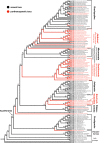Repeated convergent evolution of parthenogenesis in Acariformes (Acari)
- PMID: 33437432
- PMCID: PMC7790623
- DOI: 10.1002/ece3.7047
Repeated convergent evolution of parthenogenesis in Acariformes (Acari)
Abstract
The existence of old species-rich parthenogenetic taxa is a conundrum in evolutionary biology. Such taxa point to ancient parthenogenetic radiations resulting in morphologically distinct species. Ancient parthenogenetic taxa have been proposed to exist in bdelloid rotifers, darwinulid ostracods, and in several taxa of acariform mites (Acariformes, Acari), especially in oribatid mites (Oribatida, Acari). Here, we investigate the diversification of Acariformes and their ancestral mode of reproduction using 18S rRNA. Because parthenogenetic taxa tend to be more frequent in phylogenetically old taxa of Acariformes, we sequenced a wide range of members of this taxon, including early-derivative taxa of Prostigmata, Astigmata, Endeostigmata, and Oribatida. Ancestral character state reconstruction indicated that (a) Acariformes as well as Oribatida evolved from a sexual ancestor, (b) the primary mode of reproduction during evolution of Acariformes was sexual; however, species-rich parthenogenetic taxa radiated independently at least four times (in Brachychthonioidea (Oribatida), Enarthronota (Oribatida), and twice in Nothrina (Oribatida), (c) parthenogenesis additionally evolved frequently in species-poor taxa, for example, Tectocepheus, Oppiella, Rostrozetes, Limnozetes, and Atropacarus, and (d) sexual reproduction likely re-evolved at least three times from species-rich parthenogenetic clusters, in Crotonia (Nothrina), in Mesoplophora/Apoplophora (Mesoplophoridae, Enarthronota), and in Sphaerochthonius/Prototritia (Protoplophoridae, Enarthronota). We discuss possible reasons that favored the frequent diversification of parthenogenetic taxa including the continuous long-term availability of dead organic matter resources as well as generalist feeding of species as indicated by natural variations in stable isotope ratios.
Keywords: Oribatida; backbone; diversification; evolution; mites; phylogeny; sex.
© 2020 The Authors. Ecology and Evolution published by John Wiley & Sons Ltd.
Conflict of interest statement
The authors have no conflict of interest.
Figures

Similar articles
-
Origin and higher-level diversification of acariform mites - evidence from nuclear ribosomal genes, extensive taxon sampling, and secondary structure alignment.BMC Evol Biol. 2015 Sep 2;15:178. doi: 10.1186/s12862-015-0458-2. BMC Evol Biol. 2015. PMID: 26330076 Free PMC article.
-
Molecular phylogeny of oribatid mites (Oribatida, Acari): evidence for multiple radiations of parthenogenetic lineages.Exp Appl Acarol. 2004;33(3):183-201. doi: 10.1023/b:appa.0000032956.60108.6d. Exp Appl Acarol. 2004. PMID: 15347023
-
Convergent evolution of aquatic life by sexual and parthenogenetic oribatid mites.Exp Appl Acarol. 2016 Dec;70(4):439-453. doi: 10.1007/s10493-016-0089-3. Epub 2016 Oct 26. Exp Appl Acarol. 2016. PMID: 27785647
-
Fifty shades of bacterial endosymbionts and some of them still remain a mystery: Wolbachia and Cardinium in oribatid mites (Acari: Oribatida).J Invertebr Pathol. 2022 Mar;189:107733. doi: 10.1016/j.jip.2022.107733. Epub 2022 Feb 17. J Invertebr Pathol. 2022. PMID: 35183553 Review.
-
[Origin and evolution of parasitism in mites of the infraorder Eleutherengona (Acari: Prostigmata). Report I. Lower Raphignathae].Parazitologiia. 2008 Sep-Oct;42(5):337-59. Parazitologiia. 2008. PMID: 19065835 Review. Russian.
Cited by
-
Oribatid mites in different Mediterranean crop rotations fertilized with animal droppings.Exp Appl Acarol. 2023 Aug;90(3-4):185-202. doi: 10.1007/s10493-023-00812-4. Epub 2023 Jun 20. Exp Appl Acarol. 2023. PMID: 37338638 Free PMC article.
-
Older Lineages of Oribatid Mites in Mountain Ranges Have Broader Geographic Ranges and Exhibit More Generalistic Traits.Ecol Evol. 2025 Feb 28;15(3):e71046. doi: 10.1002/ece3.71046. eCollection 2025 Mar. Ecol Evol. 2025. PMID: 40027424 Free PMC article.
-
Haplotype divergence supports long-term asexuality in the oribatid mite Oppiella nova.Proc Natl Acad Sci U S A. 2021 Sep 21;118(38):e2101485118. doi: 10.1073/pnas.2101485118. Proc Natl Acad Sci U S A. 2021. PMID: 34535550 Free PMC article.
-
"Jack-of-all-trades" is parthenogenetic.Ecol Evol. 2022 Jun 23;12(6):e9036. doi: 10.1002/ece3.9036. eCollection 2022 Jul. Ecol Evol. 2022. PMID: 35784052 Free PMC article.
-
A georeferenced database of the edaphic biota currently available for Argentina.Biodivers Data J. 2023 Oct 25;11:e113079. doi: 10.3897/BDJ.11.e113079. eCollection 2023. Biodivers Data J. 2023. PMID: 37927382 Free PMC article.
References
-
- Arribas, P. , Andújar, C. , Lourdes Moraza, M. , Linard, B. , Emerson, B. C. , & Vogler, A. P. (2019). Mitochondrial metagenomics reveals the ancient origin and phylodiversity of soil mites and provides a phylogeny of the Acari. Molecular Biology and Evolution, 37, 683–694. 10.1093/molbev/msz255 - DOI - PubMed
-
- Balogh, J. , & Balogh, P. (1988). Oribatid mites of the Neotropical region. I. Akadémiai Kiadó Press.
-
- Balogh, J. , & Balogh, P. (1990). Oribatid mites of the Neotropical region II. Akadémiai Kiadó Press.
-
- Balogh, J. , & Balogh, P. (2002). Identification keys to the oribatid mites of the extra‐holarctic regions. Well‐Press Publishing Limited.
-
- Bell, G. (1982). The masterpiece of nature: The evolution and genetics of sexuality. University of California Press.
LinkOut - more resources
Full Text Sources

